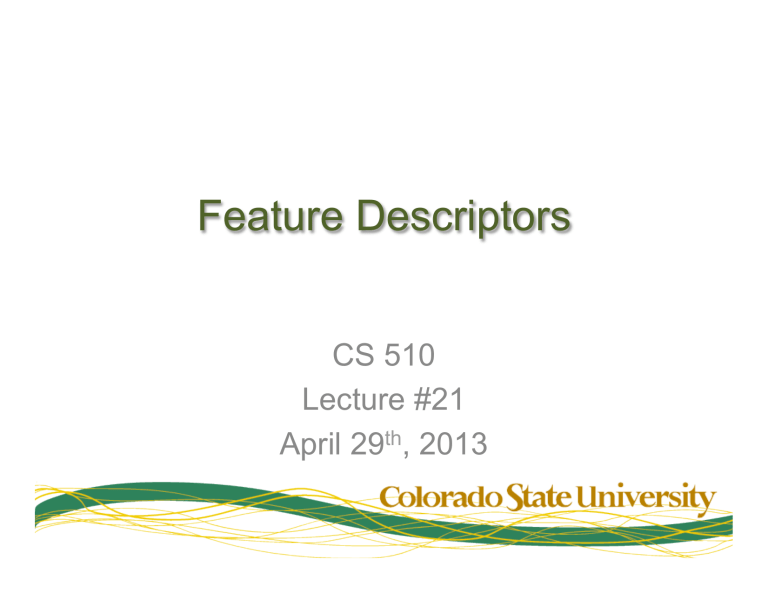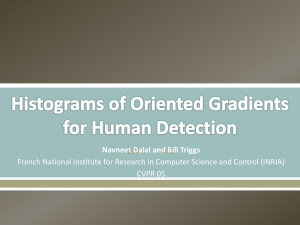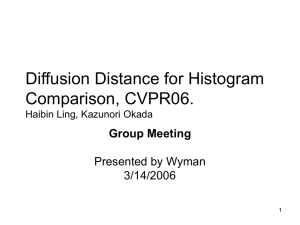Uploaded by
juancarlos.sanmiguel
Feature Descriptors: SIFT, HoG, LBP - Computer Vision
advertisement

Feature Descriptors CS 510 Lecture #21 April 29th, 2013 Programming Assignment #4 • Due two weeks from today – Any questions? – How is it going? Where are we? • We have two umbrella schemes for object recognition – Bag of Features, Constellations • We bootstrap these with feature detections – Interest points, regions, etc. • To implement these, we looked at – Clustering (K-Means, EM) – Classification (SVM, Backprop, Bayes nets, Decision trees, Nearest neighbors) • These algorithms view samples as points in highdimensional feature spaces. Where do the features come from? High-dimensional Feature Descriptors • Goal: describe the properties of image features – “similar” features should be near each other in feature descriptor space – “dissimilar” features should not be – Insensitive to changes in • Viewpoint • Scale • Illumination Terminology Confusion • Feature : a distinctive local property of an image – Interest point – Region – Line, curve, etc. • Descriptor : a high dimensional vector describing a feature – Vectorized image patch – SIFT descriptor, LBP, Haar, … When we say feature space, we typically mean feature descriptor space SIFT Interest Point Descriptor • SIFT Interest Points are extrema of the DoG responses to an image pyramid • SIFT descriptors are 128-dimensional vectors describing the image patch around a SIFT interest Point – SURF descriptors are very similar (but avoid the patent issues) • In OpenCV, you can compute the SURF descriptor for any (x,y,s) image point – Even if its not a SIFT/SURF interest point Review: Interest Points – Location (x,y) – Scale • Measured in octaves • SIFT: 1/3 octaves http://computervisionblog.wordpress.com/tag/sift-feature-point/ • Properties SIFT Descriptor Step 1: Scale • If scale ≠ 1, image is down-scaled around the interest point – Every octave is a power of 2 – Non-integer octaves require bilinear image interpolation (see beginning of course) • SIFT descriptors are based on the 16x16 scaled image patch around the interest point Step 2: Rotation • Goal: compensate for in-plane rotation • Calculate the intensity derivatives in (x,y) of the 16x16 scaled image patch – Convolution with Sobel masks – Produces (dI/dx, dI/dy) for every pixel • Produce the structure tensor: ( * * * * * ) " ∂I % $ ' # ∂x & 2 ∂I ∂I ∂x ∂y ∂I ∂I ∂x ∂y " ∂I % $ ' # ∂y & 2 + , Step 2: Rotation (cont.) • The first eigenvector of the structure tensor is the dominant edge direction • Rotate the scaled image patch so that the x axis is aligned with the dominant edge direction Step 3: Localized Edge Orientation Histograms • The 1st 2 steps produce a scaled and rotated 16x16 image patch • Divide this patch with a 4x4 grid. Each cell contains 4x4 pixels. Step 3: Localized Edge Orientation Histograms (cont.) • For each grid cell, histogram the rotated (dx, dy) edges – Histogram buckets are edge orientations • 8 orientation buckets (45° each) – Weights voted by edge magnitude • √(dx)2+(dy)2 • Smoothed by a 1/2σ Gaussian • Feature vector is the concatenation of 16 8-bucket histograms (128 dimensions) SIFT descriptors: why? • Two points are similar if: – They have similar nearby edges (orientation & strength) – In similar positions, relative to the points • Descriptors are insensitive to: – Scale (points are rescaled) – In-plane rotation (points are rotated to dominant edge direction) – Average illumination (based on edges; assuming no clipping or floor effects) SIFT descriptors: why? (cont.) • Sensitivity is minimized with regard to: – Small translations (± 1pixel) • Histograms insensitive to movements within 4x4 grid cell • Edge weight smoothing minimizes boundary effects – Small affine distortions • Small viewpoint changes can be roughly approximated by small changes in in-plane rotation and translation Feature Vector Length Intuition • 128 dimensions is in feature vector “sweet spot” – Too few dimensions è not enough ways for samples to differ – Too many dimensions èdistributions become uniform – Many of the best feature descriptors are in the range [50, 500] in length HoG: Histogram of Gradients • HoG is a variation on SIFT descriptors – Operates on image patches (not necessarily around interest points) – No compensation for scale or rotation – Computes magnitude-weighted edge orientation histograms (like SIFT) – Allows for different number of cells, cell shapes, and orientation bin counts – Biggest difference: descriptor blocks HoG Descriptor Blocks • HoG descriptors are applied to larger image patches, which may have internal changes in illumination • HoG descriptors use more cells (to cover large patches) • Cells grouped in descriptor blocks – Descriptor blocks overlap; cells are in more than one block Descriptor block normalization • A normalization constant is calculated for every descriptor block • Based on edge magnitudes within the block – Most often based on sum of Euclidean lengths – Other normalization function get played with • Edge magnitudes are normalizes prior to histogram voting Texture: Localized Binary Patterns (LBP) • A feature vector to describe the texture within an image (patch) • Like SIFT & HoG, begin by dividing the image patch into localized cells • Compute a histogram for each cell • Concatenate the histograms of the cells into a longer vector LBP (theory) • The difference is that in LBP, a texture measure is histogrammed (not edges) • For every pixel, do the following: – Evenly sample 8 points on a circle of radius r, centered at the pixel • Interpolate pixel values (bilinearly) as needed – For each sample, return ‘1’ if sample is brighter than center pixel, ‘0’ otherwise – Interpret string of 8 bits as a binary integer • 0 to 255 • Create a histogram of the 256 texture values LBP Illustrated (Scholarpedia) LBP (practice) • Problem: 256 bins is “too many” – Concatenation creates vectors outside of “sweet spot” (length > 500) – Most values in histogram are zero • Solution: transitions in 8-bit vector are rare – Count how many 1’s are followed by 0’s (and vice-versa) – 90+% of pixels in practice have fewer than 2 transitions • So just histogram these! • Pattern transition counts – Two patterns have 0 transitions (all 1’s, all 0’s) – 16 patterns have 1 transition – 32 patterns have 2 transitions • 48-dimension LBP – Histogram all 1 & 2 transition patterns • 51-dimension LBP – Add 0 transition patterns, and one bin for “other” LBP Applied http://www.mathworks.com/matlabcentral/fileexchange/36484-local-binary-patterns Iconic Representation • A lower-dimensional representation of a point (or small image patch) • Result of multi-scale convolution with loworder wavelets • “Steerable” – response at orientation θi predicts the response at θj. • Responses are independent of each other Iconic Representation Masks • Each row is a scale • 10 masks per scale • Masks are “steerable” http://www.sciencedirect.com/science/article/pii/S0042698902000408





